

How to Write a Speech - English GCSE Exam (Updated for 2019)

It’s your English GCSE exam, and you’ve been asked to write a speech. You might never have done that before. So, how do you write a speech?
First of all, don’t freak out. If you haven’t done it before, writing a speech can sound intimidating. But, with the right techniques, anyone can write a speech that will score well in a GCSE English exam.
A speech is simply an official verbal presentation that is meant to achieve a certain goal. The aim of making a speech or even writing one, is to convince your audience to buy into your idea or pay attention to your subject of discussion.
In an exam setup, an examiner might ask you to write a speech on a particular topic, or you could be asked to imagine yourself as someone else and giving a speech to a different audience. Here are a few tips to help you prepare to score top marks in your GCSE English exam.
1. Introduce yourself

The first thing to do in any speech you write, is to introduce yourself. If you’ve seen footage of historic speeches, the speaker might skip over the formality of introducing themselves, or they might be introduced by someone before they take the stage.
Put that out of your mind - for your GCSE speech, you need to make an introduction.
In fact, your introduction is an opportunity. An opportunity to show your examiners that you can adapt to introduce yourself to any audience. Here’s two examples of different audiences and how you could introduce yourself appropriately:
You’re giving a speech to your teachers Because you’re talking to your teachers, in this example, your introduction would need to be more formal. For instance; “Hello, and thank you for taking the time to listen. My name is Lawrence Smart, and I’m here today to talk to you about…” Notice how the speech writer in this example uses their full name and is very polite to his audience.
You’re making a speech to your classmates In this example, your language can be more casual. Your classmates already know who you are, so you could say; “Hi everyone. Most of you know me already know me - my name’s Shanice. I’m the one who always sits at the back of the class.” This speech writer is far less formal, but that’s perfect for her audience. She is speaking to her equals, and she can connect with them far more effectively by using the language they would usually use with each other.
Remember - your introduction is an opportunity. Be creative and introduce yourself to your audience with the tone you mean to go on with.
2. Make a great opening statement
Now the audience know who you are, it’s time to make them pay attention.
You should always begin writing your speech in a way that is catchy. You want to craft an introduction that will captivate your target audience. A good opening statement is fairly brief, but uses language techniques to make an immediate impact.
To begin your speech, try using some of the following language techniques:
A rhetorical question Rhetorical questions are questions that you don’t expect your audience to answer. So why use them? Because they make your audience think. When you ask a question that your audience wants to know the answer to, they will pay attention. If you then provide an answer to your own question, your audience will be hooked. Example: “I’m here to talk to you about what ordinary people can do to fight against climate change. Why? Because we’re running out of time to act.”
A surprising statement Surprise is a powerful tool in any speech. It makes your audience sit up and pay attention. Think of the most surprising opinion or fact you want to convey in your speech. Now, use it right at the beginning.
A famous quote Before your exam, take a look at a list of famous quotes . Don’t worry about revising famous quotes before your exam: the quote itself won’t get you marks. But, if you can remember one which is relevant to your speech topic, use it. It will demonstrate your creativity and flair. Example: “As a wiser woman than me once wrote: ‘It is our choices, that show what we truly are, far more than our abilities.’”
Think about how these different techniques effectively grab your attention, and remember that you can do the same with your speech.
3. Structure your speech
To structure your speech and make it easy for your audience to understand your point, split it into three sections: Introduction, main body, and conclusion. In each section you’re trying to achieve a different aim:
In the Introduction , your aim is to tell your audience who you are and what you’re talking about. Then, you want to grab their attention.
The main body of your speech is where you make your arguments. Divide this main body into 2-3 points, and separate each point into different paragraphs.
At the end, comes the conclusion . A good conclusion takes everything you said and sums it up.
Watch Mr Bruff’s video for some helpful tips and examples of how to structure your speech.
4. Begin every paragraph with a topic sentence

Because you’re dividing your speech into separate paragraphs, it’s important to make it clear what each section is about. To do that, ensure that you have topic sentences for each paragraph.
For example: “Jellyfish are the second thing I want to put into Room 101, and for good reason.”
5. Use very good English
Good English is essential for your examiner to give you good marks.
But don’t worry, if you’re not confident, there are couple of tricks you can use to avoid making mistakes:
Avoid long sentences. Write short sentences instead. By keeping things short, you limit the amount of complex punctuation you need to use. However, bear in mind that for the top marks, examiners are looking for a range of sentence structures and punctuation.
Practice. It’s a simple tip but it’s the best one I can give you. Trying anything for the first time takes your attention away from your grammar and spelling, and that can lead to mistakes. Practice makes perfect, and it also makes you more confident.
Watch this video for examples of common mistakes you want to avoid in your English exam.
6. Express your opinion
The most common mistake students make when writing a speech is that they don’t express an opinion.
Opinions are the element that make a speech interesting. Whatever you are writing a speech about, express yourself. Don’t just write about your topic, write what you think about it .
What if you don’t have a strong opinion on the subject? Imagine you do, and write from that perspective. The examiner won’t care about your opinion, or whether they agree with it. What they will care about is that you are expressing an opinion in a persuasive, engaging way.
7. Write from the 1st person and engage your audience
When writing your speech, always ensure that you write using the 1st person. This means, use “I” as you write. By doing this, your audience will recognise that what you’re saying is your opinion.
You should also address your audience directly as if you were actually talking to them. Use “we” and “you” in your writing. For example: “I’m sure you’d all agree that...”, or “As a community, we need to…”.
Using the 3rd person makes each of your audience members sit up and listen. It makes them think about how your topic and argument applies to them.
8. Use personal details and anecdotes
Every good speech writer aims to make the audience relate to them. If your audience relates to you, they are far more likely to agree with what you’re saying.
One of the best ways to do that is to tell a short story about yourself, or provide short personal details. You don’t want to spend too much time talking about yourself and not about your argument, but small details will bring your speech to life.
Here’s some examples:
In a speech about bullying, you might say: “Like it is for so many young people, bullying is a subject that is close to my heart. When I was at primary school, I was bullied and I now know how harmful it can be.”
For a speech about music, you could say: “Ever since the day I first heard Kanye West’s Runaway , I knew I’d be a lifelong fan.”
If you were talking about sport, you might say: “I was never a good rugby player. But, football? My school’s muddy, overgrown football field is where I found my true calling.”
9. Use rhetorical questions
Use rhetorical questions throughout your speech, just like I suggested you should do in your opening. Remember: rhetorical questions grab your audience’s (and your examiner’s) attention.
But, don’t use too many questions, or you’ll begin to sound like you don’t know what you’re talking about! A good rule of thumb is to use 2-3 rhetorical questions in throughout your speech, each in different paragraphs.
10. Use emotive language
Emotive language is one of the most basic, but most effective tools a speech writer can use.
In your speech, things shouldn’t simply be described just as “good” or “bad”. They should be “fantastic” or “horrible”, “pure” or “corrupted”, “exciting” or “disappointing”. Notice how these example words express more than just “good” or “bad”, they also add other flavours to your description.
But, be careful not to over-use emotive language. If you go go over the top it can reduce the effectiveness of all of your words. Use emotive words sparingly throughout your speech.
For more emotive language examples, read this article .

11. Use figurative language
As with emotive language, this shouldn’t be over-used. But, used sparingly, figurative language creates powerful images in your audience’s mind. There are many types of figurative language, but these are the main ones you should focus on using in your speech:
Simile - Describing something to be like something else. For instance, “She has eyes like a hawk ”, “He’s thin as a twig ”, or “They’re fighting like cats and dogs ”.
Metaphor - Describing something by using a word that isn’t literally relevant. For example, “It’s raining men”, “I’m feeling blue ”, or “The weather was bitterly cold”.
Imagery - Using words to make you imagine how they would affect your senses. For example; “A sweet apple”, “A sharp pin”, or “The lion roared ”.
For more figurative language techniques and examples, read this article .
12. Use contrast
Contrast is a powerful technique. It highlights your point because of the clash of imagery it creates in the audience’s mind.
You can exploit this by using contrasting words and phrases in your sentences. For instance; “I love writing, but I hate writing essays”.
You can also bring added flavour to your figurative language, by using contrasting imagery. For example, you could describe one person as a “fiery and passionate” and another as “cold-hearted”.
13. Use repetition
Repetition is for emphasis. Repetition is memorable. Repetition is one of many persuasive techniques which will help you get a good grade.
As I’ve just done, starting consecutive sentences with the same word is a very effective technique.
Repetition can also be used for key phrases in your introduction and conclusion to bring your speech full circle. For instance, if you started your speech by saying “The pen is mightier than the sword”, repeat that phrase in the conclusion to your speech.
14. Use the list of three
We don’t know exactly why, but the human brain easily remembers things in threes. Use this to your advantage.
When you’re using a list of adjectives to describe something, use three. When you’re
A very common technique is to combine repetition with the list of three. By repeating a word three times in consecutive sentences, you can make a very compelling point.
15. Focus on the topic
When writing a speech in an English exam, always stay focused on the topic you have been asked to write about. Never derail from the subject of the speech you are writing. This will make you lose marks.
This is why it is so important to plan your speech before you begin writing it. Think through the structure you are going to use and stick to it. That way, you’ll stay on topic and your argument will be focused.
Writing a good speech is fairly simple, all you need is practice, practice and more practice before sitting for your GCSE English Exam. And if you have any questions, ask me in the comments.
The following acronym might help you remember some of the points we have discussed and help you score highly in your English exam.
P-ersonal anecdotes to bring your speech to life E-motive language to persuade your audience. R-hetorical questions to make your audience listen. F-igurative language such as metaphors and similes. E-mphasis through repetition and the rule of three. C-omparison and contrast to make your points clear. T-one of voice that is relevant and persuasive for your specific audience.
We’ve also created a study group on Facebook to learn together, answer questions as well as to conduct live sessions with various innovative and creative individuals from all walks of life, get a sneak peek into their lives and what drives them!

Lacking study motivation? The problem isn’t you, the problem is your routine. With the right routine, you can re-wire your brain, up your energy and make it far easier for you to stay motivated while revising.

Approaching your exam there is an overwhelming feeling of regret, disappointment and anger. The following are some tips to help you in planning independent work so that you can feel confident when that deadline or exam finally comes around.

Did you know that you can “trick” your brain into remembering information? Here are Love Learning Tutors’ favoured methods of revision, perfect for keeping key ideas in your noggin during exam season, whether you're doing your GCSE, A Levels or IB exams!
Compulsory Sex, Relationship and Health Education for 2020
How to make revision notes for gcse, a level and ib (8 top tips).
Resources you can trust
How to write and deliver a speech
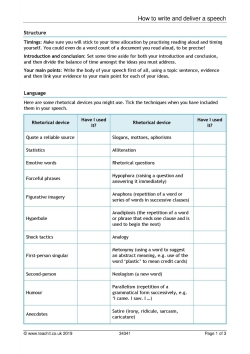
Detailed advice on how to develop a convincing line of argument and engage your audience, as well as a checklist of the language features of a formal speech. The resource includes comprehensive notes on the following aspects to support students plan and rehearse a speech:
All reviews
Have you used this resource?
Resources you might like
Talk to our experts
1800-120-456-456
- Easy Steps to Write an Effective Speech

A Step-by-Step Guide to Writing an Effective Speech: Tips and Examples
A speech is a way to share your thoughts or stand up for a cause. To make an effective speech, it's important to not only speak clearly, but also to carefully plan what you'll say. By preparing your speech well, you can ensure your message is delivered effectively. At Vedantu, students can learn how to create strong speeches with a clear structure and engaging content.

The platform offers resources to help students practise speech writing, improve their presentation skills, and gain confidence in public speaking. This preparation helps students communicate their ideas better and make a strong impact on their audience.
| help everyone understand and follow what you’re saying. |
How to Write a Speech?
Writing a speech involves thorough research and careful planning to effectively convey your message. Great speeches often include compelling details and inspiring content that resonates with the audience. Learning to write impactful speeches can be achieved with a bit of guidance. Here’s a step-by-step guide to help you craft a speech:
Self Introduction Start your speech by introducing yourself. If there's a host or master of ceremonies, they might introduce you first. Regardless, you should clearly state who you are and briefly explain what your speech will cover. The introduction can be formal or informal, depending on your audience. For example, a formal introduction might include your professional title, while an informal one might simply mention your name and a fun fact.
Introduction to the Topic Next, introduce the topic of your speech. Provide a brief overview of what you will discuss. Make sure to grab the audience's attention with a hook, like a surprising fact or a question. This helps in engaging the audience right from the start.
Main Points Outline the key points you want to address in your speech. Make sure each point is clear and relevant to the topic. Use examples, anecdotes, or data to support your points. This helps in making your speech more relatable and persuasive.
Conclusion End your speech with a strong conclusion. Summarise your main points and restate the purpose of your speech. Aim to leave a lasting impression by delivering a memorable closing statement or call to action.
Practice and Delivery Finally, practice your speech several times. Focus on your tone , pace, and body language. Practising helps you deliver your speech confidently and effectively, ensuring that your message is communicated clearly to your audience.
Addressing Friends/Classmates/Peers
Hello everyone! My name is ________, and today, I’d like to discuss _________ with you all.
Good morning, friends. I am ________, and I am excited to speak with you about _________.
Addressing Teachers/Higher Authorities
Good morning/afternoon/evening. I would like to begin by thanking _______ for the opportunity to share my thoughts on _________ today.
Good day to everyone. I am ________, and I am honoured to speak about _________ with you.
The Opening Statement
The first seven seconds of a speech are crucial, as they determine whether the audience will stay engaged. Therefore, starting with a compelling opening statement is essential to capture their attention. Crafting a speech involves thorough research and structuring it in an engaging, informative, and coherent way is crucial.
When assigned a topic, begin by brainstorming ideas and jotting down everything that comes to mind. This process helps identify which aspect of the topic to focus on, guiding the drafting of your speech.
An effective opening statement should be relevant to your topic. Use clever wording to make a strong impression and capture the audience's interest . Here are some strategies for framing an engaging opening statement:
Asking an Engaging Question Starting with a question can immediately grab the audience's attention. It sparks curiosity and encourages them to think, thus preparing them to listen more attentively.
Fact or a Surprising Statement Presenting an intriguing fact or statement can captivate the audience. This could include a joke, as long as it's relevant and appropriate. A well-timed laugh can refresh their interest and make them eager to hear more.
Adding a Quote Select a quote that aligns with your topic and resonates with your audience. Whether it’s from a famous person or a story, a relevant quote can add depth and set the tone for your speech. Choose a quote that is memorable or thought-provoking to make a significant impact.
Choice of Words
When delivering or writing a speech, it's crucial to choose your words with care. Selecting the right language is essential, whether you're expressing support for or opposition to a topic. Be sure to provide sufficient evidence to back up your points. Use short, clear sentences to enhance the impact of your speech. Your choice of words and what you emphasize will shape how your audience perceives your message.
When writing a speech, ensure that you:
Avoid long, confusing sentences.
Check for spelling, grammar, and sentence structure errors.
Refrain from using contradictory statements that might confuse the audience.
Authenticity
Authenticity in a speech engages the audience more effectively. Incorporate personal anecdotes, experiences, and genuine thoughts to build rapport. However, stay focused on the topic and avoid getting sidetracked with unrelated details.
Writing in 1st Person
Using the first-person perspective in a speech can be more effective than a third-person approach. However, make sure it does not become too subjective or divert from the main topic.
Tips for Writing a Speech
Before you start writing, know what your speech is about and what you want to achieve. Decide if you want to inspire, entertain, or inform your audience.
Think about who will be listening to your speech. Tailor your content to fit their interests and needs so they stay engaged.
Make sure your speech is clear and to the point. Avoid making it too long or it might become boring. Stick to the important details.
After writing your speech, check it for mistakes and make changes if needed. Practice saying it out loud so you feel confident and don’t stumble.
Finish your speech by summarising the main ideas. Leave your audience with something to think about, so they remember your message.
Format on How to Write a Speech
Here’s a structured format of How to write a speech:
Start with a clear and engaging title that reflects the main topic of your speech.
2. Introduction
Greet the audience and introduce yourself.
State the purpose of your speech.
Give a brief overview of what you will talk about to grab the audience's attention.
Main Points : Organise your speech into several main points. Each point should be clear and supported with examples, evidence, or anecdotes.
Sub-points : Include supporting details under each main point to add depth and clarity.
4. Transitions
Use smooth transitions between different points to help your speech flow naturally.
5. Conclusion
Summarise the key points of your speech.
Restate the purpose or main message.
End with a strong closing statement or call to action to leave a lasting impression.
6. Q&A (if applicable)
Prepare to answer any questions from the audience if your speech includes a question-and-answer session.
7. Practice
Rehearse your speech multiple times to ensure you are familiar with the content and delivery.
How to Write a Speech: Examples
Example 1: Speech on Environmental Conservation
Good morning everyone!
My name is John Smith, and today I’m here to talk about the importance of environmental conservation. Our planet is facing severe challenges due to pollution, deforestation , and climate change. We must take action to protect our environment .
Firstly, we need to reduce our waste by recycling and composting. Secondly, conserving energy by using renewable sources is essential. Lastly, planting more trees will help restore balance in our ecosystems.
Each one of us can make a difference by adopting these simple practices in our daily lives. Together, we can ensure a healthier planet for future generations. Thank you for your attention!
Example 2: Speech on the Importance of Education
Good afternoon everyone!
I’m Sarah Johnson, and I’m excited to discuss the value of education in our lives. Education is not just about gaining knowledge, but also about preparing ourselves for the future. It opens doors to new opportunities and helps us grow personally and professionally.
To begin with, education empowers individuals to make informed decisions. It also enhances critical thinking and problem-solving skills. Finally, it helps us understand and appreciate diverse cultures and perspectives.
Investing in education is investing in a better future for ourselves and our communities. Let’s value and support educational opportunities for everyone. Thank you!
To Test Your Knowledge of How to Write a Speech, try these Tasks:
Task 1 - Write a Short Speech: Pick a topic you are passionate about, such as your favourite hobby or a cause you care about. Write a 3-minute speech on this topic. Make sure to include a clear introduction, main points, and a conclusion. Practise delivering your speech in front of a mirror or a friend.
Task 2 - Analyse a Famous Speech: Watch a famous speech online, like Martin Luther King Jr.’s “I Have a Dream” or a speech from a recent event. Take notes on how the speaker introduces themselves, the key points they make, and how they conclude. Try to identify any special techniques they use to keep the audience engaged and use these techniques in your speech writing.
Now check out if you got them all right from the answers below:
Task 1 - Write a Short Speech:
Good morning everyone,
Today, I want to talk about something that has a huge impact on our lives – reading. Reading is not just a way to pass the time; it is a gateway to knowledge and imagination. Through books, we explore different worlds, understand diverse cultures, and learn new ideas. Reading also helps improve our language skills and concentration. Whether it's a novel, a biography, or a magazine, each piece of reading material offers something valuable. I encourage all of you to make reading a part of your daily routine. It’s a small habit that brings great rewards. Thank you.
Taks 2 -Review and Improve a Sample Letter:
To analyse a famous speech like Martin Luther King Jr.’s “I Have a Dream,” start by noting how he introduces himself and sets the tone. King begins with a reference to the Emancipation Proclamation, connecting his message to historical struggles for freedom. He introduces his main points by addressing the ongoing racial injustice and articulating his dream of equality, creating a vivid picture of a hopeful future. His conclusion uses a powerful repetition of the phrase “I have a dream” to reinforce his vision and leave a lasting impression. The speech employs imagery, metaphors, and emotional appeals to engage the audience. To apply these techniques, focus on a strong introduction, clear key points, and a memorable conclusion in your speech, using repetition and vivid descriptions to make it impactful.
Takeaways from this Page
Writing a speech involves careful planning and practice. Begin with a clear introduction to capture attention and state your main points clearly. Use simple and engaging language to keep your audience interested. Rehearse your speech to ensure smooth delivery and correct any mistakes. Finally, end with a strong conclusion that reinforces your main message and leaves a lasting impression.

FAQs on Easy Steps to Write an Effective Speech
1. How to write a speech format?
To understand how to write a speech format, start by organising your speech into three main parts: introduction, body, and conclusion. Clearly outline your main points and supporting details. This format helps in delivering a structured and effective speech.
2. How to write a welcome speech?
When learning how to write a welcome speech, begin with a warm greeting and introduce yourself. Mention the purpose of the event and the key individuals present. Keep it brief and engaging to set a positive tone for the event.
3. How to write a speech on teacher's day?
To write a speech on Teacher's Day, start by expressing appreciation for teachers. Highlight their contributions and impact on students' lives. Use personal anecdotes or quotes to make the speech heartfelt and memorable.
4. How to write a welcome speech for chief guest?
When writing a welcome speech for a chief guest, ensure you acknowledge their presence respectfully. Mention their achievements and the significance of their visit. Craft your speech to reflect the honour of having them as a guest.
5. How to write a speech for students?
For writing a speech for students, choose a topic relevant to their interests and needs. Use simple language and relatable examples. Structure your speech to be engaging and motivational to keep students attentive.
6. What is the best way to structure how to write a speech format?
The best way to structure how to write a speech format is to divide your speech into three main parts: introduction, body, and conclusion. This format helps in organizing your thoughts and ensures a clear flow of ideas.
7. How to write a welcome speech effectively?
To write a welcome speech effectively, start with a friendly greeting and introduce yourself. Outline the purpose of the event and acknowledge key guests or participants. Make sure to keep it concise and engaging.
8. How to write a speech on teacher's day to make it impactful?
To make a speech on Teacher's Day impactful, focus on the role of teachers in shaping students' futures. Share personal stories or experiences that highlight their dedication. Conclude with a heartfelt thank you.
9. How to write a welcome speech for chief guest in a formal setting?
Writing a welcome speech for a chief guest in a formal setting involves greeting them warmly, mentioning their achievements, and explaining the importance of their presence. Keep the tone respectful and appreciative.
10. How to write a speech for students to ensure it is engaging?
To ensure a speech for students is engaging, choose a topic that resonates with their interests. Use simple language and interactive elements. Structure your speech to include relatable examples and a motivational conclusion.
11. What are the key points in how to write a speech format?
Key points in how to write a speech format include having a clear introduction, a well-organized body with main points, and a strong conclusion. This format helps in delivering a coherent and effective speech.
12. How to write a welcome speech for various events?
How to write a welcome speech for various events involves greeting the audience, introducing the event’s purpose, and acknowledging any special guests. Tailor the speech to fit the nature of the event and keep it engaging.
- Sign in or Register

- EYFS / KS1 English Teaching Resources
- KS2 English Teaching Resources
- KS3 English Teaching Resources
- GCSE English Teaching Resources
- Join Membership
- Contact Get in touch
- Member Login Access your account
Speech Writing for GCSE - teaching resource
* Watermarks do not appear on purchased resources
Click on images to enlarge
Speech Writing for GCSE (72-slide PowerPoint based unit of work with 7 worksheets)
Speech Writing for GCSE explains how to write an effective speech and score high marks in the GCSE English exam. The resource explores transactional writing on the GCSE English exam and focuses on speech writing in detail. It guides students through the process of how to plan, write and draft an effective speech and reveals what examiners are looking for.
Speech Writing for GCSE covers the following:
- What is Transactional Writing?
- Understanding the GAP - genre, audience and purpose – and its impact on a speech
- How to plan, structure and organise an effective speech
- Understanding and using the key techniques of speech writing
- Exemplar student speeches for modelling and peer assessment
- Identifying problems in learners’ work and creating solutions
- Using the GCSE mark scheme for peer and self-assessment and to help learners understand what they need to do to gain high marks
- Producing an effective speech under exam conditions
To preview Speech Writing for GCSE please click on the images opposite.
Get access to thousands of pages of resources. Find out more about membership here.
Writing Speeches KS4 Revision
You need to login or register to continue, description.
Revision for KS4 for the Eduqas English Language Paper, focussing on how to write a speech and the type of question that the students could be asked. I wrote the speech that is used as an example - it is about Prostate Cancer, so feel free to edit this and include your own.
Author Info

MissOsterritter
Download info, march 17, 2021.
- Primary Hub
- Art & Design
- Design & Technology
- Health & Wellbeing
- Secondary Hub
- Citizenship
- Primary CPD
- Secondary CPD
- Book Awards
- All Products
- Primary Products
- Secondary Products
- School Trips
- Trip Directory
- Trips by Subject
- Trips by Type
- Trips by Region
- Submit a Trip Venue
Trending stories


Top results

- 6 Of The Best Speaking And Listening Resources For Ks4 English
Speaking and listening topics – Best resources for GCSE English

Get ready to debate, persuade, agree, disagree and of course empathise with these excellent ideas for the speaking and listening exam…

Are your students preparing to choose their speaking and listening topics for GCSE English? Use these resources, lesson plans and activities to help them get the mark they deserve…
80 speaking and listening topics
Speaking and listening resources, activities to turn students into great public speakers, more speaking and listening resources, easy ways to introduce oracy in secondary.
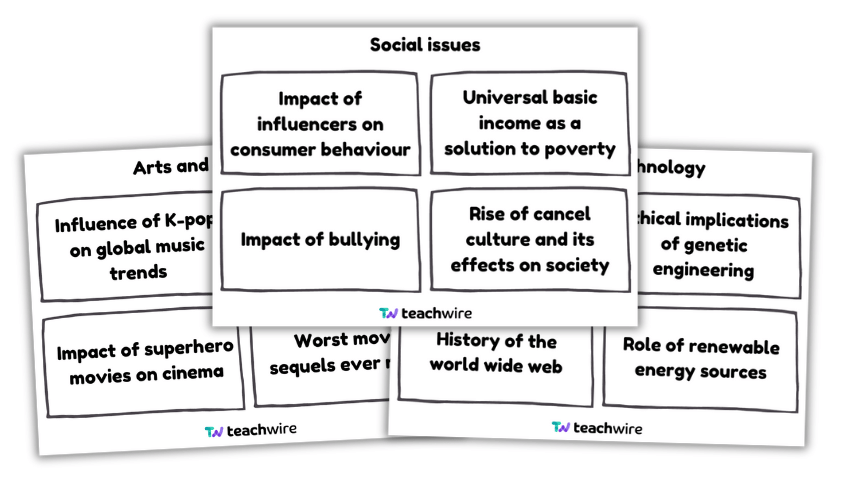
This free English speaking and listening download contains a PowerPoint with 80 topic ideas to inspire your students. There’s also a PDF version too for easy printing.
Subject areas covered include social issues, environmental issues, health and wellbeing, education, science and technology, entertainment, humour and more.
This down-to-earth video from a fellow student is a great one to show in class. It covers choosing your topic, practising your speech, answering questions and more.
Craft a persuasive speech

In this free lesson plan from English teacher Stu Fink, all students will get the opportunity to speak (and, more importantly, to listen). You’ll explore why it’s important for politicians to be able to communicate well.
Students will then debate a series of controversial statements in groups. Finally, students will work on preparing super-short speeches (just 15 seconds!) and delivering them effectively. It’s great practice for their own speaking and listening topics later down the line.
Persuasive writing scheme and resources
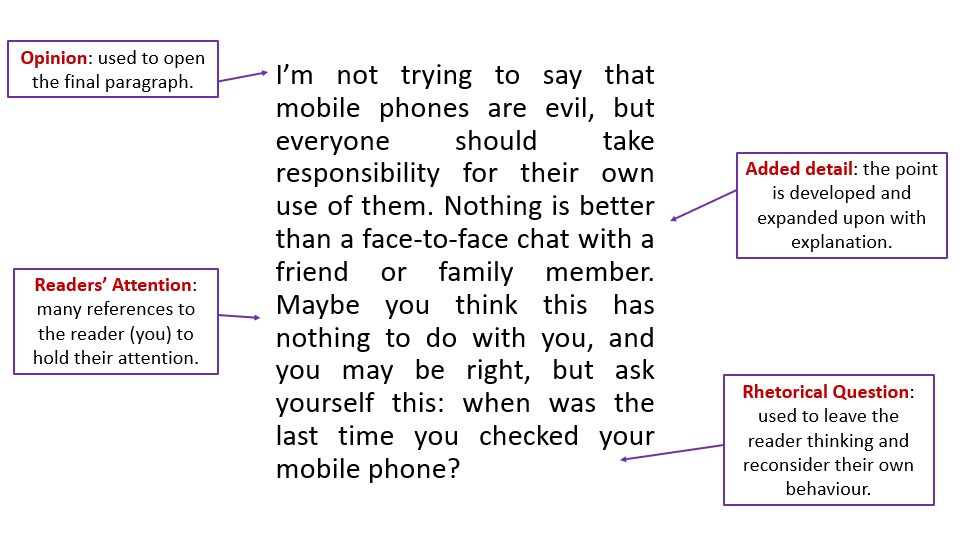
This free persuasive writing unit contains a sequence of lessons all about speech writing. Resources include example speeches that introduce the idea of speech structure and persuasive devices.
There are also examples of good speech introductions, main bodies and conclusions. The assessment task involves writing a speech addressing one of three given speaking and listening topics – Disney and gender inequality; the value of arts subjects; homework.
Speaking and listening topic examples
Watch student Jibreel giving his speech on the topic of free will – which received a distinction.
Here’s another speech awarded a distinction. This time, Charlotte is talking on the theme of why large retailers are killing off the high street and what can be done about it.
Three listening and speaking activities
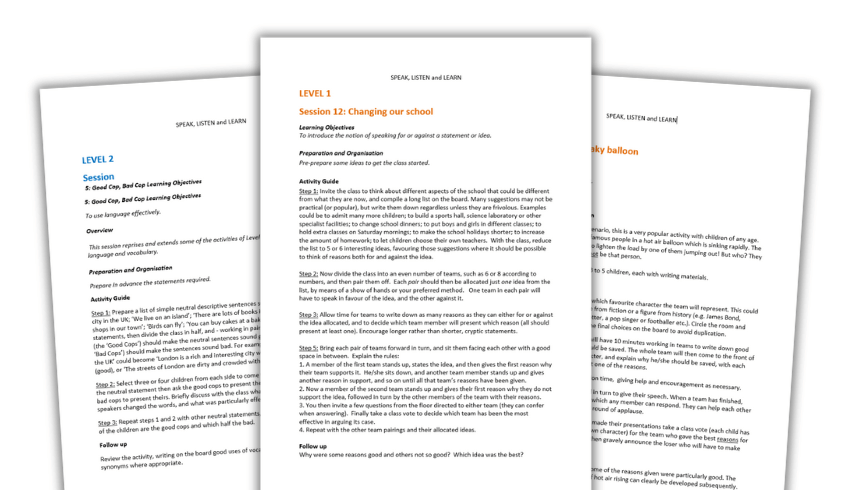
This free download contains instructions for three listening and speaking activities . The activities are:
- Leaky balloon – a thought experiment that helps students to make and respond to simple arguments
- Changing out school – a debate exercise that introduces the idea of speaking for or against an idea
- Good cop, bad cop – working in teams, students prepare presentations about a neutral statement

Public speaking doesn’t come naturally to everyone, says Alison Davies – but these fun activities can help students develop the skills they need to succeed…
For those with little or no experience of addressing an audience – like most of our students – it can be a terrifying ordeal with the potential to affect their communication skills well into adulthood.
So how can we make the transition from desk to centre stage an easy one for learners? The key is to make the experience fun. Be creative and give your students the tools they need to speak with confidence and imaginative flair.
Show them not only how to plan what they want to say, but also how to say it in an engaging way – then let them take the floor and shine! Try these ideas…
The Road Show Game
As a starter activity to encourage spontaneity, confidence and creative thought, get your students to sit in a large circle.
Explain that they’re going to discuss the origins of an object that you’ll pass around the circle. Choose an everyday object, like a stapler, paperclip, wallet or doorstop. The onus is on them to use their imagination!
They must pretend that they’re antiques experts and come up with a story about the object’s background and what it’s used for – but this must be something original that hasn’t been said before.
The object can be an artefact from the past, or a future antique. They can be as creative as they like, but they must say something when it comes to their turn.
This activity promotes ‘on the spot’ thinking and active listening, since they have to take note of each other’s opinions. It will also help them express their ideas in a creative and engaging manner.
Go around the circle at least twice. This will encourage everyone to be inventive and boost their confidence, once they realise that they can improvise and come up with new ideas when under pressure.
Telling someone else’s story
Often students are challenged to present ideas and facts which aren’t necessarily their own, thus making the delivery even more of a trial. Help them take ownership of information and improve their general presentation techniques with this fun activity.
Start by asking them to write down the brief outline of a memory. Encourage them to pick something positive, like a fantastic holiday, event or an achievement, or even something amusing that makes them laugh.
In pairs they should swap and read each other’s tales. When they’ve finished, they must take their partner’s memory and make it their own by delivering it as a story ‘from personal experience’ to the rest of the class.
How to do it
To help them prepare, work through the following checklist of tasks
- Ask them to split the tale into easy sections, so that it follows a narrative pattern. Sticking to this structure means that if they go off tangent they can find their way back by picturing the segments of the story in their mind.
- Get them to consider what the story is about, and to make it important to them. Ask them what they feel the core message is. This doesn’t have to be the same as the person who the memory belongs to, as they’ve now taken ownership of it.
- Once they’ve identified the core message and planned what they want to say in a story format, ask them to walk through the tale in their mind and engage all their senses. Encourage them not only to see events unfold, but to consider what they can feel, hear, smell, touch etc.
- Get them to think about the emotions within the story and how to portray these through the tone, pitch and pace of their voice, facial expressions and body language.
- Finally, ask them to think about the story’s core message and how they can reinforce this when presenting the memory.
Finish by sitting in an informal circle and allowing each student to share their memory. At the end, ask the other students to guess what the core message was. In preparing a personal tale, the students will grow in confidence and develop their communication skills.
Know your audience
Before any talk or presentation it’s important to consider your audience. Who are they and what do they expect from you? The most accomplished speaker in the world will fail to connect with their audience if they don’t fulfil their expectations.
Split the students into small groups and give them a piece of information to present in the form of a paragraph about a particular subject or a short newspaper report.
Once they’ve read it, they must identify five key questions that any audience would want to know. This will help them pick out the crucial points they need to deliver and place them in order of importance.
Take this a step further by asking each member of the group to deliver one point. They must organise the presentation as a team and focus on how they’re going to get their particular message across, using the skills they’ve practised previously.
Taking a stand
‘ The Old Man, His Son and the Ass ‘ is a fable that tells the story of a man and his son taking their ass to market. During the journey they meet different people, each of whom has their own personal view on who should or should not be sitting on the ass.
The man attempts to please everyone to the point of carrying the ass on his shoulders. This ends in disaster, as the ass falls into the river and is never seen again. The moral of the tale being, you can’t please all of the people all of the time.
Tell the story, and then ask the students to pick a character. They must take a stand and deliver that character’s version of events to the rest of the class. This means they have to tell the tale from their perspective, explaining why they said or did what they did.
To help, give your students the following list of tips:
- Believe in what you’re saying
- Picture what you want to deliver
- Engage your emotions and senses wherever possible
- Consider how language sounds
- Use your voice to get the message across
- Plan using the narrative structure
- Enjoy – and remember you are in control
Alison Davies is an author of several fiction and non-fiction books, a professional storyteller and creative practitioner, running workshops at universities throughout the UK and delivering sessions on creative communication and memory building techniques. Visit alisonlrdavies.blogspot.co.uk . Browse more of our oracy resources .
Are graffiti artists criminals?

Is grafitti art that adds to a culture and a community? If so, who gets to judge that? Where is the line between art and nuisance? Where, if anywhere, might it be acceptable to do it?
Download two PowerPoint presentations to help you explore this idea in class.
You’re no doubt familiar with the TV show format, where contestants attempt to persuade the host that their item should be banished for all eternity into Room 101.
Well, it makes for a great speaking and listening activity. If you want to see it in action, here’s a school that filmed their effort and uploaded it to YouTube. There’s also a free PowerPoint lesson plan .
Analysing famous speeches as arguments

This extensive resource spans five 50-minute lessons, covering these areas:
- Analysing a speech for rhetorical devices and their purpose
- Identifying an author’s purposeful manipulation of language
- Identifying elements of argument within a speech
- Writing an analysis of a speech with in-text documentation

Instead of screaming in frustration at the ongoing oracy policy vacuum, take some meaningful steps towards improving matters with these ideas from English teacher Jennifer Hampton…
Start by developing a heightened awareness of talk opportunities in your classroom. Who is speaking, and when can you increase those opportunities? Some strategies might include ‘no hands up’ time, think pair share activities and utilising group feedback.
Could your class’ group work activities benefit from guidelines, modelling or sentence openers to facilitate discussion?
You can also think about your curriculum. Could you build up students’ confidence in presenting via the gradual introduction of shorter speaking tasks at KS3? This doesn’t have to be just in English, but across all subjects.
Another step you could take is to analyse the results of your spoken language components for yearly trends. Probe how well your PP-eligible students are faring in this part of the course.
Demand CPD opportunities and research time, with support from the brilliant organisations and advocates of oracy in the classroom that are among the biggest voices currently clamouring for change, such as Voice 21 and Oracy Cambridge .
Start the conversation with colleagues and senior leaders. Seek to involve students more actively in assemblies, and explore other opportunities for public speaking. Find out what our students think about their oracy development via class surveys, exit slips and questionnaires.
Jenny Hampton ( @brightonteacher ) is an English teacher, literacy lead and former SLE (literacy) .
Sign up to our newsletter
You'll also receive regular updates from Teachwire with free lesson plans, great new teaching ideas, offers and more. (You can unsubscribe at any time.)
Which sectors are you interested in?
Early Years
Thank you for signing up to our emails!
You might also be interested in...
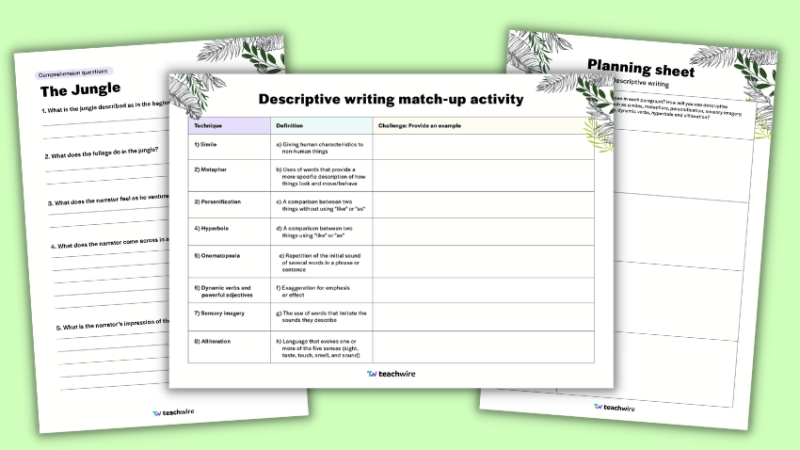
Why join Teachwire?
Get what you need to become a better teacher with unlimited access to exclusive free classroom resources and expert CPD downloads.
Exclusive classroom resource downloads
Free worksheets and lesson plans
CPD downloads, written by experts
Resource packs to supercharge your planning
Special web-only magazine editions
Educational podcasts & resources
Access to free literacy webinars
Newsletters and offers
Create free account
By signing up you agree to our terms and conditions and privacy policy .
Already have an account? Log in here
Thanks, you're almost there
To help us show you teaching resources, downloads and more you’ll love, complete your profile below.
Welcome to Teachwire!
Set up your account.
Lorem ipsum dolor sit amet consectetur adipisicing elit. Commodi nulla quos inventore beatae tenetur.
I would like to receive regular updates from Teachwire with free lesson plans, great new teaching ideas, offers and more. (You can unsubscribe at any time.)
Log in to Teachwire
Not registered with Teachwire? Sign up for free
Reset Password
Remembered your password? Login here

Lesson resources
Starter quiz questions
Starter quiz answers
Exit quiz questions
Exit quiz answers
Your details
Thanks for downloading.
We hope you find the resources useful. Click the question mark in the bottom-right corner to share your feedback.
- International
- Topical and themed
- Pre-K and Kindergarten
- Middle school
- High school
- Special education
- Schools directory
- Resources Jobs Schools directory News Search
English: Debates and speeches
Australia and new zealand, international schools, tes resources team.

Speaking and listening lessons, activities and supporting tools for exploring debating and speeches
Improving speaking and listening skills, building self-esteem, learning to write persuasively and deliver arguments convincingly are essential life skills. So, why not get started? We’ve picked out a few of our favourite resources shared by teachers in the Tes community to help you do exactly that.
Looking for resource collections? Take a look at our English collection.
Exploring debates and speeches

Speech Writing
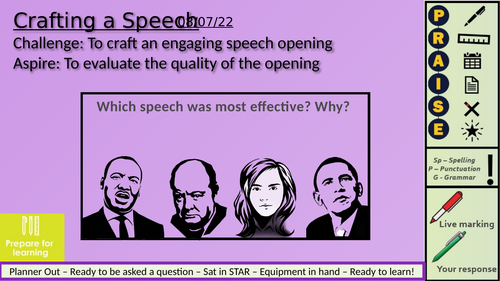
KS3 Speech Writing: The Plastics Debate
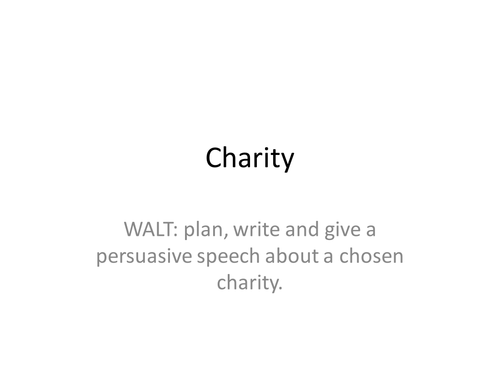
Writing to Persuade: Charity Speech
Encouraging debates and speeches.
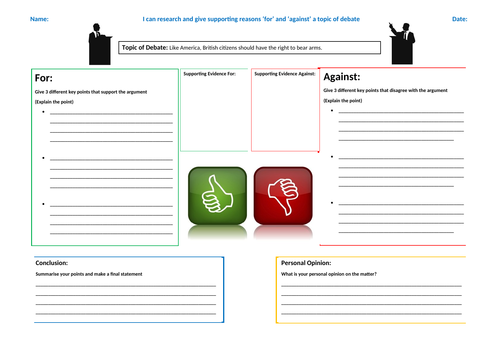
KS4 SEN - English - Speaking - Debates - For & Against - Templates

The Great Debate - Starter, tutor time and more!

Debate (Tutor time or lesson)
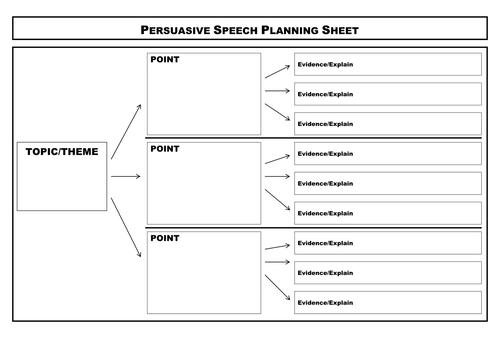
Persuasive Speech
Supporting debates and speeches.

DEBATING SKILLS HANDOUTS

Literacy: A Writing Frame to Discuss / Debate

Interactive Persuasive Devices Quiz (using DAFOREST techniques)
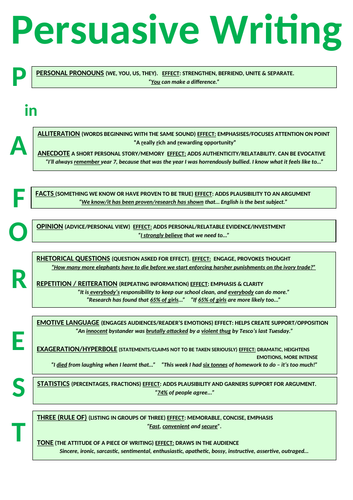
Persuasive Writing Techniques - P in A FOREST

IMAGES
COMMENTS
Key learning points. The topic of your speech is the main subject matter. The topic needs to be developed into a thesis statement which expresses your main argument. Think about the who, what and why of the topic in order to create a thesis statement. Rhetorical techniques need to be employed carefully- it is important to avoid overusing them.
docx, 26.72 KB. docx, 28.11 KB. pptx, 342.58 KB. doc, 27 KB. Lessons designed to assist GCSE students with writing a speech. The first lesson generates some discussion and recognition of features of a speech, with the second lesson focusing on the students creating their own speech. This was designed for IGCSE but can be used for any sessions.
Buy my revision guides in paperback on Amazon*:Mr Bruff's Guide to GCSE English Language https://amzn.to/2GvPrTV Mr Bruff's Guide to GCSE English Literature...
Key learning points. Use of direct address and personal pronouns reflect the live context of speech-making. Discourse markers and interjections add a spoken quality to speech-writing. Various repetition devices, such as anaphora and refrain, are used in speech-writing to drive a message. Aural devices, such as alliteration and onomatopoeia ...
Worksheet. An advice sheet with information and tips for students to use when they write a speech. The key features of speech writing are covered and include having an inspiring opening and ending, using emotive language and including facts and figures. The resource also includes a planning grid template. 48 KB. Download. 82.72 KB. Free download.
Write a speech for your class in which you persuade your listeners to be a force for change. Correct answer: persuade, speech and students. persuade, speech and students. entertain, email and friends. inform, speech and general public. advise, article and newspaper . Q6.
Persuasive speech writing. Lesson that encourages students to write a persuasive speech using examples and techniques. Also focusses on using different sentence types and topic sentences. Report this resource to let us know if it violates our terms and conditions. Our customer service team will review your report and will be in touch.
Speech writing is the method of conveying a thought or message to a reader using the correct punctuation and expression. Speech writing isn't much different from any other form of narrative writing. There are8 parts of speech in the English language. These parts are nouns, pronouns, verbs, adjectives, adverbs, prepositions, conjunctions, and ...
When writing a speech in an English exam, always stay focused on the topic you have been asked to write about. Never derail from the subject of the speech you are writing. This will make you lose marks. This is why it is so important to plan your speech before you begin writing it. Think through the structure you are going to use and stick to it.
Q1. What is a topic sentence? a sentence which states what your paragraph is going to be about. a sentence which introduces a quote in your writing. a sentence which concludes your paragraph. Q2. Match the devices to the examples. statistics -. 63% of young people under 18 said they struggled with this.
Speaking tasks: Speeches and presentations. Detailed advice on how to develop a convincing line of argument and engage your audience, as well as a checklist of the language features of a formal speech. The resource includes comprehensive notes on the following aspects to support students plan and rehearse a speech: delivery.
Format on How to Write a Speech. Here's a structured format of How to write a speech: 1. Title. Start with a clear and engaging title that reflects the main topic of your speech. 2. Introduction. Greet the audience and introduce yourself. State the purpose of your speech. Give a brief overview of what you will talk about to grab the audience ...
Speech Writing for GCSE (72-slide PowerPoint based unit of work with 7 worksheets) Speech Writing for GCSE explains how to write an effective speech and score high marks in the GCSE English exam. The resource explores transactional writing on the GCSE English exam and focuses on speech writing in detail. It guides students through the process ...
Speech Writing. Subject: English. Age range: 14-16. Resource type: Other. I aim to provide mainly English Language and Literature resources ranging from PowerPoints, Lesson Plans to Learning Mats and Worksheets. Achieving a First Class Degree in Secondary English Education with QTS, I hope to share some knowledge and ideas whilst learning along ...
docx, 16.92 KB. docx, 13.17 KB. pptx, 10.73 MB. docx, 14.58 KB. docx, 20.82 KB. GCSE Speech writing questions, model answers and a peer assessment checklist. Creative Commons "Sharealike". A very generous share- some really well planned resources. Thank you.
Revision for KS4 for the Eduqas English Language Paper, focussing on how to write a speech and the type of question that the students could be asked. I wrote the speech that is used as an example - it is about Prostate Cancer, so feel free to edit this and include your own. LitdriveUK is formally recognised by the CFSA as a subject association ...
Key learning points. Choose your speech topic by focusing on current affairs, personal interests or information on a specific subject. A good speech can be a blend of three categories. A good speech needs an engaging hook in the opening. Organise your points with good transitions.
Persuasive writing scheme and resources. This free persuasive writing unit contains a sequence of lessons all about speech writing. Resources include example speeches that introduce the idea of speech structure and persuasive devices. There are also examples of good speech introductions, main bodies and conclusions.
Malala's Nobel speech demonstrates that texts can have multiple purposes in order to engage an audience. Malala demonstrates an effective use of humour alongside her important messages of education and peace. like Malala, successful speeches engage their audiences, through a range of rhetorical devices. logos, ethos and pathos give writers ...
Download .zip. Select and download free lesson resources, including slide decks, worksheets and quizzes.
KS4 SEN - English - Speaking - Debates - For & Against - Templates. £1.00. (1) Writing templates created to prompt thought and discussion around 'For & Against' sides to a debate. Areas to include research of the topic of debate and provide supporting evidence. Used with KS4 SEN English Group preparing for Speaking & Listening exams.